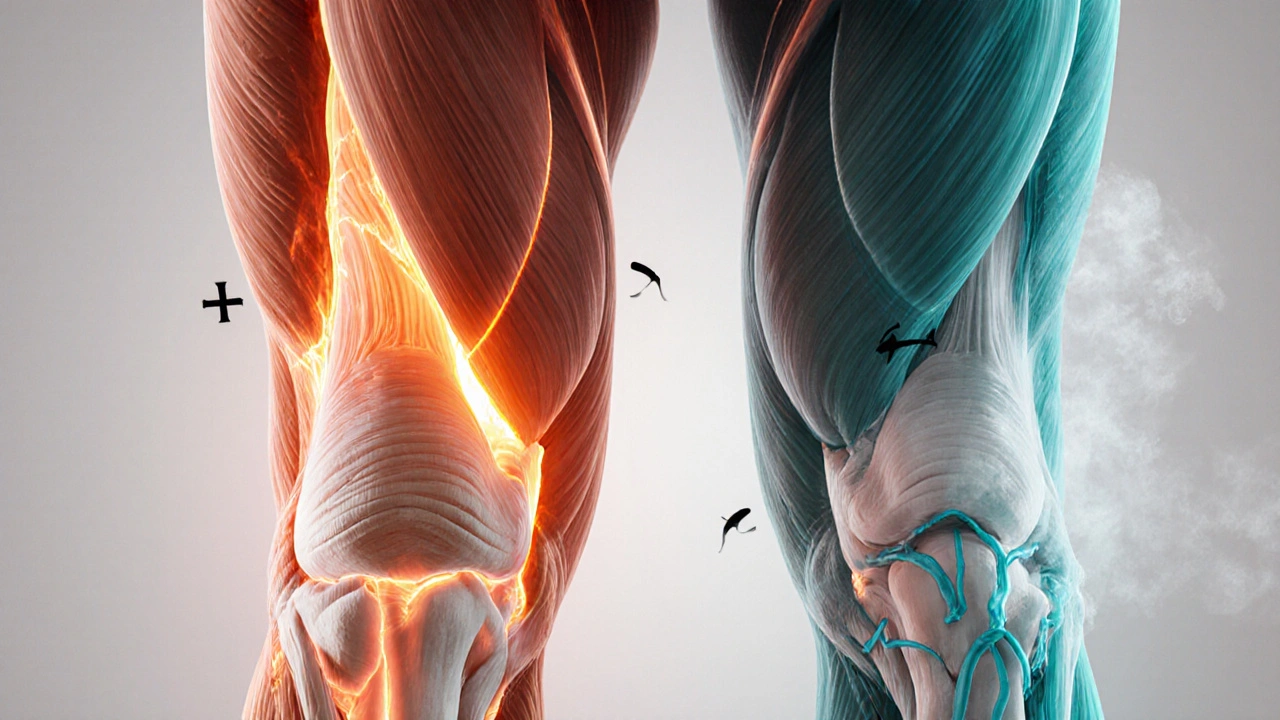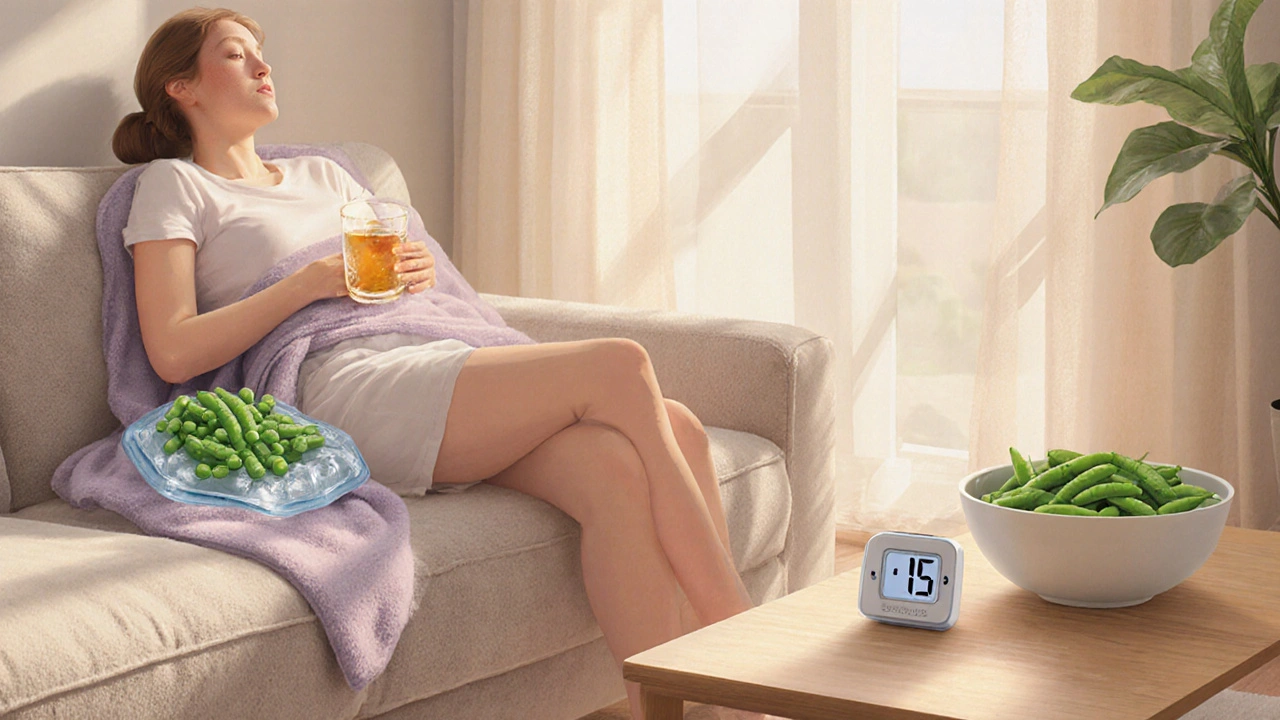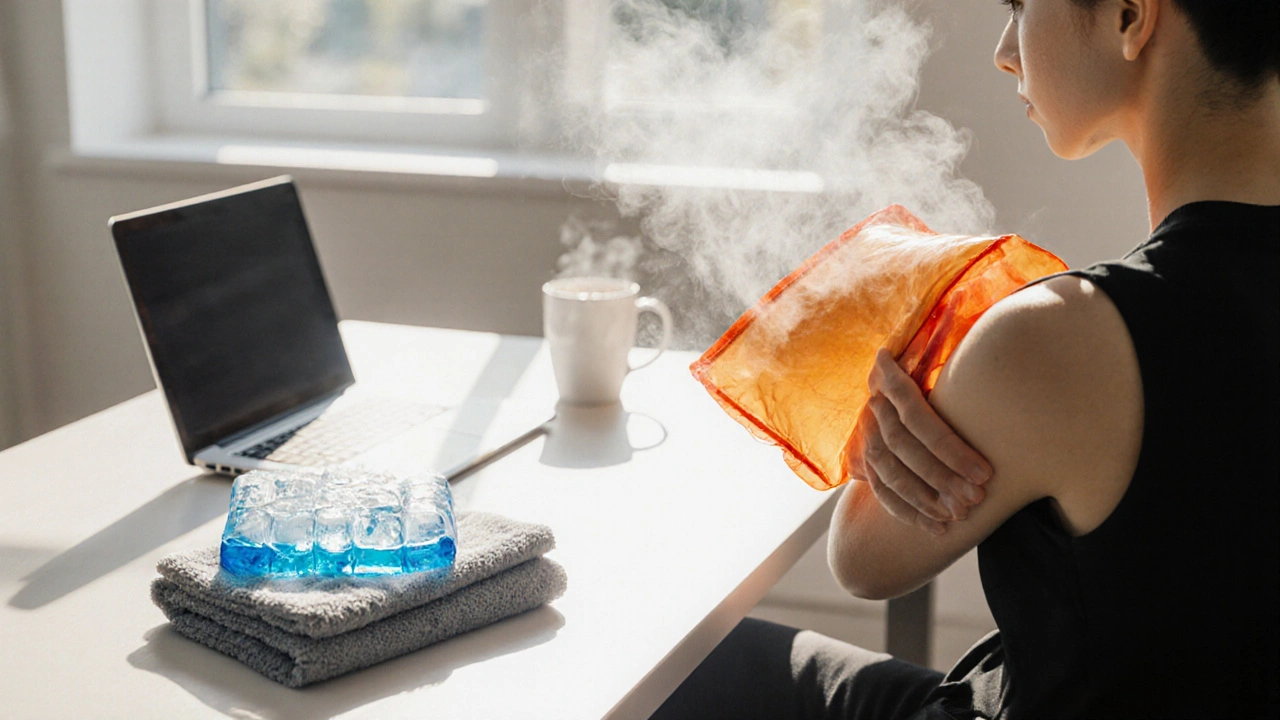Heat vs Cold Therapy Selector
Recommended Therapy
Heat Therapy
Best for muscle tightness, chronic pain, and stiffness.
Temperature: 38-45°C (100-113°F)
Cold Therapy
Best for acute swelling, bruises, and recent injuries.
Temperature: 0-15°C (32-59°F)
Muscle ache is a daily annoyance for many people, whether it comes from a long day at the desk, a tough workout, or a minor sprain. While over‑the‑counter pain relievers are handy, the easiest and most natural way to calm sore muscles is to dial the temperature up or down. Heat and Cold Therapy a set of temperature‑based treatments that target muscle soreness by applying heat or cold to the affected area works by changing blood flow, nerve activity, and inflammation levels.
Key Takeaways
- Apply heat and cold therapy at the right time to speed up recovery.
- Heat boosts blood flow and relaxes tight fibers; cold reduces swelling and numbs pain.
- A simple 15‑20minute session is enough for most aches.
- Know the contraindications - no heat on open wounds, no ice on areas with poor circulation.
- Home tools like a microwaveable pad or a reusable gel pack are cost‑effective alternatives to professional devices.
How Heat Therapy Works
When you wrap a warm pack around a sore muscle, the temperature typically rises to 38‑45°C (100‑113°F). This warmth causes blood vessels to dilate, a process called Thermogenesis the generation of heat within body tissues that increases local blood flow and metabolic activity. More blood means more oxygen and nutrients reaching the damaged fibers, which speeds up the repair process. Heat also reduces the firing rate of pain‑sensing nerves, making the ache feel less intense.
Common heat sources include electric heating pads, hot water bottles, warm towels, and even a hot‑shower spray. For deeper tissue work, moist heat (like a damp towel warmed in the microwave) penetrates better than dry heat, delivering lasting relief for chronic stiffness or mild strains.

How Cold Therapy Works
Cold therapy, also known as Cryotherapy the therapeutic use of low temperatures to reduce tissue damage and pain, typically brings skin temperature down to 10‑15°C (50‑59°F). This cooling triggers vasoconstriction, which limits blood flow to the injured area and curtails swelling. Less fluid buildup means reduced pressure on nerve endings, translating into a numbing effect that dulls pain signals.
Ice packs, frozen peas, and gel wraps are the go‑to tools for cold therapy. In sports medicine, a brief 10‑minute ice application right after an injury is the gold standard for minimizing bruising and inflammation.
Heat vs Cold: When to Use Which
| Aspect | Heat Therapy | Cold Therapy |
|---|---|---|
| Target Condition | Muscle tightness, chronic soreness, arthritis | Acute swelling, bruises, recent sprains |
| Temperature Range | 38‑45°C (100‑113°F) | 0‑15°C (32‑59°F) |
| Typical Duration | 15‑20minutes, 2‑3 times daily | 10‑15minutes, up to 3 times daily |
| Main Physiological Effect | Increases blood flow, relaxes muscles | Reduces blood flow, limits inflammation |
| Contraindications | Open wounds, infection, loss of sensation | Raynaud’s disease, poor circulation, frostbite risk |
In practice, the rule of thumb is simple: heat for stiffness, cold for swelling. If you’re dealing with a dull, achy muscle that feels tight, reach for a warm pad. If the area is swollen, red, or you’ve just twisted it, grab an ice pack.
Safe Application Tips
- Always place a thin cloth between skin and the heat or cold source to avoid burns or frostbite.
- Start with the shortest recommended time (10minutes for ice, 15minutes for heat) and increase only if comfort allows.
- Never apply heat or cold for longer than 20minutes in a single session; extended exposure can damage tissue.
- Allow the treated area to return to its normal temperature before re‑applying another session.
- Keep a timer handy; it’s easy to lose track when you’re focused on relief.

Common Mistakes and Precautions
Many people make the mistake of treating every muscle ache the same way. Using heat on a freshly bruised ankle can worsen swelling, while icing a chronically stiff neck might increase tension. Also, avoid applying heat on areas with numbness (common in diabetic neuropathy) because you can’t feel if the temperature becomes harmful.
For people with cardiovascular disease, rapid temperature changes can stress the heart. If you have any chronic condition, check with a health professional before starting regular heat or cold sessions.
Home Remedies and Product Suggestions
You don’t need fancy equipment to get effective results. A simple Microwaveable Heat Pack a reusable pad filled with grains or gel that can be warmed in a microwave for 30‑60 seconds works great for lower‑back or shoulder aches. For cold therapy, a Gel Ice Pack a flexible, reusable pack that stays cold for up to 30 minutes without freezing solid conforms to joints better than a brick of ice.
If you prefer natural materials, a warm towel soaked in herbal tea (like chamomile) adds both heat and soothing aromatics. For ice, frozen fruit (e.g., peas) doubles as a snack after your session.
Frequently Asked Questions
Can I combine heat and cold in one treatment?
Yes, a technique called contrast therapy alternates hot and cold applications, usually in 3‑minute intervals. It can boost circulation, but it’s best for athletes who have guidance from a physiotherapist.
How often should I use heat or cold for chronic muscle pain?
For chronic pain, heat applied 2‑3 times a day for 15‑20minutes is typical. Cold can be used 1‑2 times after activities that trigger flare‑ups. Always give the skin a break between sessions.
Is ice ever safe for people with poor circulation?
Generally, no. Reduced blood flow means the skin can’t warm up after cooling, raising the risk of frostbite. Those with peripheral artery disease should stick to mild heat or consult a clinician.
What temperature should a heat pack reach to be effective?
Aim for 38‑45°C (100‑113°F). Anything hotter risks burns, and cooler temperatures don’t provide the vasodilation needed for relief.
Can I use a hot shower instead of a heating pad?
A hot shower can work for large muscle groups like the back, but it’s less targeted. A focused pad delivers consistent heat directly where you need it.



11 Comments
Gavin Potenza
October 5, 2025 AT 13:00Heat and cold aren't just kitchen tricks; they’re ancient allies in the battle against muscle fatigue.
When we stare at a sore hamstring we often choose the quick fix, forgetting that temperature is a messenger between our nerves and blood.
Warmth dilates vessels, inviting oxygen and nutrients like a friendly neighborhood courier delivering relief.
Conversely, cold constricts, sealing off the flood of inflammatory fluid that can swell like a storm‑tossed bay.
The paradox lies in timing: a heated blanket at night soothes chronic tension, yet a frosty pack after a sprint can halt swelling before it festers.
Philosophically, this mirrors life’s rhythm-expansion and contraction, push and pull, fire and ice.
If we ignore the principle that hot opens doors and cold shuts them, we gamble with our own recovery.
Imagine a musician warming up strings before a concert, versus a guitarist chilling a burnt pick to prevent damage; the analogy holds for our muscles.
Modern science quantifies the flow, but the intuition was known to warriors who swore by hot stones and ice rivers.
So the next time a desk‑bound coder feels a knot, let a gentle heat pad whisper, “relax,” for fifteen minutes.
And when a runner feels a sharp pang after a tumble, an ice pack should shout, “hold steady,” for ten minutes.
Consistency beats intensity; two to three sessions a day of the right temperature yields more progress than a single marathon of extremes.
Moreover, never forget the safety guardrails: no ice on numb limbs, no fire on open wounds.
By respecting these boundaries we honor both the body’s chemistry and its ancient wisdom.
In short, choose heat for stiffness, cold for swelling, and let the cycle of expansion and contraction guide you back to movement.
Virat Mishra
October 5, 2025 AT 14:40Oh man this article is like a rollercoaster of hot and cold it hits you with facts and then drowns you in nonsense but i still feel the drama of a warrior choosing fire over ice how could anyone ignore the pain
Daisy Aguirre
October 5, 2025 AT 16:20Wow the blend of science and simple home hacks here is just brilliant! 🌟 I love how you break down the temperature ranges with clear examples – it makes it so easy to grab a microwaveable pad or a bag of peas and get right to relief. The colorful analogies, like “heat opens the doors” and “cold shuts them,” really stick in my mind. For anyone dealing with a chronically stiff neck, I’d say try a moist heat towel and notice the difference in just a few minutes. And if you’ve just twisted your ankle, slap on that ice pack and feel the swelling melt away. Keep sharing this kind of practical wisdom – it’s like a warm hug for sore muscles!
Natalie Kelly
October 5, 2025 AT 18:00Just a quick tip: always put a thin cloth between skin and the pack – it saves you from burns.
Also keep the timer handy so you dont overdo it.
Tiffany Clarke
October 5, 2025 AT 19:40I feel drained just thinking about another heat hack.
Sandy Gold
October 5, 2025 AT 21:20Sure, heat & cold work, but the article oversimplifies the biochemistry – there’s more nuance than "just apply it".
For example, the role of cytokine modulation isn’t mentioned, which is a major oversight.
Anyway, you can still use the tips, just don’t treat them as a cure‑all.
Frank Pennetti
October 5, 2025 AT 23:00The protocol delineated herein aligns with evidence‑based guidelines, yet the author neglects to address the thermoregulatory feedback loops inherent in post‑exercise recovery.
Such omissions could mislead novices seeking optimal performance metrics.
Adam Baxter
October 6, 2025 AT 00:40Give it a shot today no excuses just heat for that stiff back and ice for that sore knee get moving faster
Keri Henderson
October 6, 2025 AT 02:20Listen, if you’re dealing with chronic pain, set a schedule and stick to it – heat twice a day and ice after workouts.
Consistency is key and you’ll notice improvement quickly.
elvin casimir
October 6, 2025 AT 04:00Honestly, the article’s recommendations are fine but the grammar is sloppy – “apply for 10‑15 minutes at a time” should be “apply it for 10‑15 minutes at a time”.
Pay attention to details if you want credibility.
Steve Batancs
October 6, 2025 AT 05:40From a national perspective it is essential that our citizens adopt proven methods like heat and cold therapy to maintain a robust workforce; therefore, adherence to these guidelines is not merely optional but a civic duty.